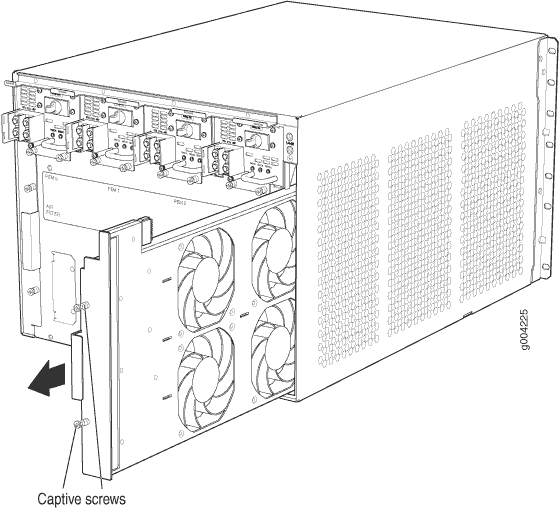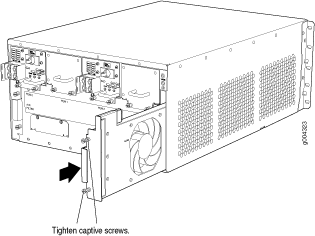- play_arrow Fast Track: Initial Installation
- play_arrow Overview
- MX240 System Overview
- MX240 Chassis
- MX240 Cooling System
- MX240 Air Deflector Kits
- MX240 AC Power System
- MX240 DC Power System
- MX240 Host Subsystem Components and Descriptions
- MX240 Line Card Components and Descriptions
- Services Processing Card—MX-SPC3 Services Card
- MX-Series Switch Control Board (SCB) Description
- play_arrow Site Planning, Preparation, and Specifications
- play_arrow Initial Installation and Configuration
- play_arrow Troubleshooting Hardware
- play_arrow Contacting Customer Support and Returning the Chassis or Components
- play_arrow Safety and Compliance Information
- General Safety Guidelines and Warnings
- Definitions of Safety Warning Levels
- Qualified Personnel Warning
- Fire Safety Requirements
- Warning Statement for Norway and Sweden
- Preventing Electrostatic Discharge Damage to an MX240 Router
- Installation Instructions Warning
- MX240 Chassis Lifting Guidelines
- Ramp Warning
- Rack-Mounting and Cabinet-Mounting Warnings
- Grounded Equipment Warning
- Laser and LED Safety Guidelines and Warnings
- Radiation from Open Port Apertures Warning
- Maintenance and Operational Safety Guidelines and Warnings
- General Electrical Safety Guidelines and Warnings
- Prevention of Electrostatic Discharge Damage
- AC Power Electrical Safety Guidelines
- AC Power Disconnection Warning
- MX240 DC Power Electrical Safety Guidelines
- DC Power Copper Conductors Warning
- DC Power Disconnection Warning
- DC Power Grounding Requirements and Warning
- DC Power Wiring Sequence Warning
- DC Power Wiring Terminations Warning
- Midplane Energy Hazard Warning
- Multiple Power Supplies Disconnection Warning
- Action to Take After an Electrical Accident
- Site Electrical Wiring Guidelines for MX Series Routers
- Agency Approvals and Compliance Statements
Maintaining the MX240 Cooling System Component
Maintaining the MX240 Air Filter
Purpose
For optimum cooling, verify the condition of the air filters.
Action
Regularly inspect the air filter. A dirty air filter restricts airflow in the unit, producing a negative effect on the ventilation of the device. The filter degrades over time. You must replace the filter every 6 months.
CAUTION:Always keep the air filter in place while the device is operating, except during replacement. The fans are very powerful and can pull small bits of wire or other materials into the device if the air filter isn't in place. These materials can damage device components.
The shelf life of polyurethane filter varies from two years to five years depending on the storage conditions. Store in a cool, dry, and dark environment. Wrap the media in plastic and store in an environment with relative humidity between 40%- 80% and temperature between 40° F (4° C) to 90° F (32° C). Note that if the material flakes, or becomes brittle when rubbed or deformed, it is no longer usable.
See Also
Replacing the MX240 Air Filter
Removing the MX240 Air Filter
Do not run the device for more than a few minutes without the air filter in place.
Always keep the air filter in place while the device is operating, except during replacement. The fans are very powerful and can pull small bits of wire or other materials into the device if the air filter isn't in place. These materials can damage device components.
To remove the air filter (see Figure 1):
- Attach an ESD grounding strap to your bare wrist, and connect the other end of the strap to an ESD grounding point.
- Loosen the captive screws on the air filter cover.
- Remove the air filter cover.
- Slide the air filter out of the chassis.

See Also
Installing the MX240 Air Filter
To install the air filter (see Figure 2):
- Attach an ESD grounding strap to your bare wrist, and connect the other end of the strap to an ESD grounding point.
- Locate the up arrow and ensure that the air filter is right side up.
- Slide the air filter straight into the chassis until it stops.
- Align the captive screws of the air filter cover with the mounting holes on the chassis.
- Tighten the captive screws on the air filter cover.

See Also
Maintaining the MX240 Fan Tray
Purpose
For optimum cooling, verify the condition of the fans.
Action
Monitor the status of the fans. A fan tray contains multiple fans that work in unison to cool the router components. If one fan fails, the host subsystem adjusts the speed of the remaining fans to maintain proper cooling. A red alarm is triggered when a fan fails, and a yellow alarm and red alarm is triggered when a fan tray is removed.
To display the status of the cooling system, issue the show chassis environment command. The output is similar to the following:
content_copy zoom_out_mapuser@host> show chassis environment Class Item Status Measurement Temp PEM 0 OK 40 degrees C / 104 degrees F PEM 1 Absent PEM 2 Absent PEM 3 OK 40 degrees C / 104 degrees F Routing Engine 0 OK 39 degrees C / 102 degrees F Routing Engine 1 OK 42 degrees C / 107 degrees F CB 0 Intake OK 26 degrees C / 78 degrees F CB 0 Exhaust A OK 27 degrees C / 80 degrees F CB 0 Exhaust B OK 27 degrees C / 80 degrees F CB 0 ACBC OK 26 degrees C / 78 degrees F CB 0 SF A OK 37 degrees C / 98 degrees F CB 0 SF B OK 35 degrees C / 95 degrees F CB 1 Intake OK 27 degrees C / 80 degrees F CB 1 Exhaust A OK 30 degrees C / 86 degrees F CB 1 Exhaust B OK 28 degrees C / 82 degrees F CB 1 ACBC OK 27 degrees C / 80 degrees F CB 1 SF A OK 36 degrees C / 96 degrees F CB 1 SF B OK 36 degrees C / 96 degrees F CB 2 Intake Absent CB 2 Exhaust A Absent CB 2 Exhaust B Absent CB 2 ACBC Absent CB 2 SF A Absent CB 2 SF B Absent FPC 2 Intake OK 22 degrees C / 71 degrees F FPC 2 Exhaust A OK 27 degrees C / 80 degrees F FPC 2 Exhaust B OK 33 degrees C / 91 degrees F FPC 2 I3 0 TSensor OK 33 degrees C / 91 degrees F FPC 2 I3 0 Chip OK 35 degrees C / 95 degrees F FPC 2 I3 1 TSensor OK 33 degrees C / 91 degrees F FPC 2 I3 1 Chip OK 33 degrees C / 91 degrees F FPC 2 I3 2 TSensor OK 33 degrees C / 91 degrees F FPC 2 I3 2 Chip OK 30 degrees C / 86 degrees F FPC 2 I3 3 TSensor OK 30 degrees C / 86 degrees F FPC 2 I3 3 Chip OK 30 degrees C / 86 degrees F FPC 2 IA 0 TSensor OK 33 degrees C / 91 degrees F FPC 2 IA 0 Chip OK 36 degrees C / 96 degrees F FPC 2 IA 1 TSensor OK 30 degrees C / 86 degrees F FPC 2 IA 1 Chip OK 35 degrees C / 95 degrees F FPC 4 Intake OK 22 degrees C / 71 degrees F FPC 4 Exhaust A OK 28 degrees C / 82 degrees F FPC 4 Exhaust B OK 31 degrees C / 87 degrees F FPC 4 I3 0 TSensor OK 31 degrees C / 87 degrees F FPC 4 I3 0 Chip OK 34 degrees C / 93 degrees F FPC 4 I3 1 TSensor OK 31 degrees C / 87 degrees F FPC 4 I3 1 Chip OK 33 degrees C / 91 degrees F FPC 4 I3 2 TSensor OK 31 degrees C / 87 degrees F FPC 4 I3 2 Chip OK 29 degrees C / 84 degrees F FPC 4 I3 3 TSensor OK 29 degrees C / 84 degrees F FPC 4 I3 3 Chip OK 29 degrees C / 84 degrees F FPC 4 IA 0 TSensor OK 35 degrees C / 95 degrees F FPC 4 IA 0 Chip OK 37 degrees C / 98 degrees F FPC 4 IA 1 TSensor OK 31 degrees C / 87 degrees F FPC 4 IA 1 Chip OK 35 degrees C / 95 degrees F FPC 7 Intake OK 20 degrees C / 68 degrees F FPC 7 Exhaust A OK 21 degrees C / 69 degrees F FPC 7 Exhaust B OK 21 degrees C / 69 degrees F FPC 7 I3 0 TSensor OK 31 degrees C / 87 degrees F FPC 7 I3 0 Chip OK 36 degrees C / 96 degrees F FPC 7 I3 1 TSensor OK 32 degrees C / 89 degrees F FPC 7 I3 1 Chip OK 35 degrees C / 95 degrees F FPC 7 I3 2 TSensor OK 32 degrees C / 89 degrees F FPC 7 I3 2 Chip OK 30 degrees C / 86 degrees F FPC 7 I3 3 TSensor OK 30 degrees C / 86 degrees F FPC 7 I3 3 Chip OK 31 degrees C / 87 degrees F FPC 7 IA 0 TSensor OK 34 degrees C / 93 degrees F FPC 7 IA 0 Chip OK 37 degrees C / 98 degrees F FPC 7 IA 1 TSensor OK 31 degrees C / 87 degrees F FPC 7 IA 1 Chip OK 35 degrees C / 95 degrees F Fans Top Fan Tray Temp OK 27 degrees C / 80 degrees F Top Tray Fan 1 OK Spinning at high speed Top Tray Fan 2 OK Spinning at high speed Top Tray Fan 3 OK Spinning at high speed Top Tray Fan 4 OK Spinning at high speed Top Tray Fan 5 OK Spinning at high speed Top Tray Fan 6 OK Spinning at high speed Bottom Fan Tray Temp OK 28 degrees C / 82 degrees F Bottom Tray Fan 1 OK Spinning at high speed Bottom Tray Fan 2 OK Spinning at high speed Bottom Tray Fan 3 OK Spinning at high speed Bottom Tray Fan 4 OK Spinning at high speed Bottom Tray Fan 5 OK Spinning at high speed Bottom Tray Fan 6 OK Spinning at high speed
See Also
Replacing the MX240 Fan Tray
Removing the MX240 Fan Tray
To prevent overheating, install the replacement fan tray immediately after removing the existing fan tray.
To remove the fan tray (see Figure 3):

See Also
Installing the MX240 Normal-Capacity Fan Tray
To install the fan tray (see Figure 4):
- Attach an ESD grounding strap to your bare wrist, and connect the other end of the strap to an ESD grounding point.
- Grasp the fan tray handle, and insert it straight into the chassis. Note the correct orientation by the this side up label on the top surface of the fan tray.
- Tighten the captive screws on the fan tray faceplate to secure it in the chassis.





















